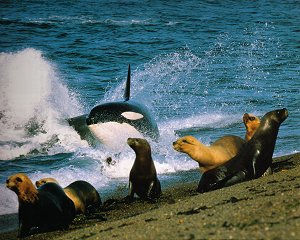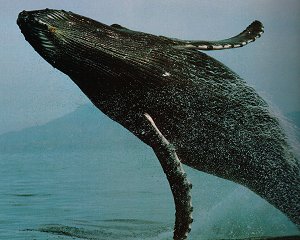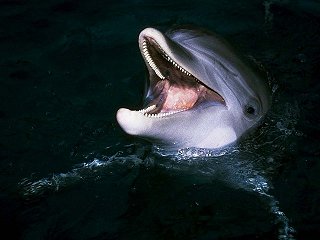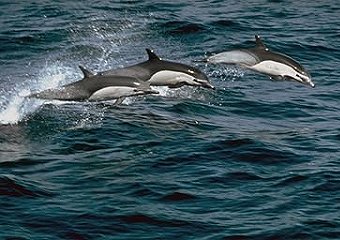THE ORDER CETACEA
Cetacea – Whale-Like Mammals (76 species.)
In every ocean of the world, and in a few rivers as well, are found whales, dolphins, and porpoises, also known as the Cetaceans, which means “whale-like.” There are 76 species, although a few are exceedingly rare. The largest living animal today is the blue whale, and it is probably the largest animal EVER to live. It averages between 80 to 100 feet in length and weighs an incredible 90 to 130 tons. That’s like having more than one million quarter-pound hamburgers. And yet the smallest Cetaceans are a number of dolphins and porpoises reaching only about 4.5 feet long when adult, and weighing only about 80 pounds.

Cetaceans have changed their appearance over the millennia, of course, to become more highly adapted for life at sea. Their hind limbs are now absent, and their forelimbs have developed into flippers while their tail is flattened out for maximum thrust. Most of them have developed a dorsal fin, and the nasal openings, or “blow-holes,” have moved to the top of the head for easier breathing, since they don’t have gills. There are no external ears, and hair is virtually lacking, so the skin remains slick for gliding through the water.
But perhaps the most amazing adaptation for air-breathing fish-like mammals is the ability of the sperm whale to dive more than TWO MILES underwater, and at the same time they must hold their breath up to TWO HOURS! Go ahead – hold your breath and time it, to see how close you can come to two hours.

It is fatal if Cetaceans become stranded on land, so even the young are born at sea. Dolphins, porpoises, and other toothed whales, the most abundant of the Cetacea order, have from one pair to 260 simple teeth. In the male narwhal, the upper left canine is a spiraled tusk that projects straight forward eight or nine feet.
Most eat fish and invertebrates, while the killer whale (a misnamed large dolphin) hunts in packs of up to fifty individuals to prey upon birds, seals, smaller Cetaceans, and other marine animals. The toothless baleen whales have long plates of stiff hairlike material, called whalebone, or baleen, which hang from each side of the palate and act as sieves to strain the plankton out of the sea, the only item on their diet. (You might recall that grandma’s corsets were often strengthened by using this “whalebone,” and thus were called whalebone corsets.)

Cetaceans are highly intelligent, social animals. They utter a vast repertoire of sounds by which they communicate with one another. Some of the larger whale sounds are of such low range, however, that they cannot be heard by humans. Because these sound waves are so low, on the other hand, they are able to travel hundreds of miles through the ocean water, possibly as far as 1000 miles, to be heard by other whales far and wide. Since whales are becoming ever rarer, perhaps this is how males and females locate one another. Whales can also navigate in the water by sonar, or echolocation, much as bats do in flight.
Check out the following specific cetaceans included:

Boutu
Baird’s Whale
Sperm Whale
Beluga
Narwhal
Commerson’s Dolphin
Spotted Dolphin
Common Dolphin
Bottlenosed Dolphin
Pacific Dolphin
Risso’s Dolphin
Orca
Pilot Whale
Fin Whale
Blue Whale
Humpback Whale
Right Whale
Gray Whale
